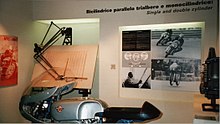Fabio Taglioni
Fabio Taglioni (* 10. September 1920 in Lugo ( RA ), Italy ; † 18th July 2001 in Bologna , Italy) was an Italian motorcycle - designer .
After studying at the University of Bologna , he joined the racing department of Mondial as an engine designer in 1943 , where he was poached by Ducati in 1954 . Ducati recognized early on that Taglioni was an extremely creative and capable head. In order to strengthen the reputation as a motorcycle manufacturer, a sports motorcycle with the least financial resources should be developed, then Taglioni in record time with the 100 cc large Gran Sport ( " Marianna also bewerkstelligte"). Even more than successful. In the racing version of this motorcycle, the desmodromic system developed by Taglioni for the forced control of the valves was used for the first time , which is a feature of all Ducati today.
After numerous single cylinders, Taglioni constructed the four-cylinder Apollo in 1963 with a 1260 cm³ V-engine , which was to compete with the big Harley-Davidson as a police motorcycle . Ultimately, it did not go into series production, but with its unusual cylinder arrangement it created the basis for the development of a two-cylinder V-engine with one facing the direction of travel and one upright, which earned Taglioni the reputation of an ingenious designer and which became typical for Ducati. This cylinder arrangement, which can only be found at Ducati, enabled high top speeds due to the small frontal area and still ensured reliable air cooling of both cylinders. The cylinder angle of 90 °, which is ideal for balancing the masses, minimized engine vibrations .
Taglioni's last development that went into series production was the Pantah series presented in 1977 , which was characterized by a low-maintenance and less complex valve control drive using toothed belts instead of vertical shafts . The later further developed engine with two valves per cylinder was installed until the end of the century.
In 1986, for reasons of age, Taglioni left Ducati, at least officially, to which he remained loyal as a highly regarded consultant until his death in 2001.
| personal data | |
|---|---|
| SURNAME | Taglioni, Fabio |
| BRIEF DESCRIPTION | Italian motorcycle designer |
| DATE OF BIRTH | September 10, 1920 |
| PLACE OF BIRTH | Lugo (Emilia-Romagna) |
| DATE OF DEATH | July 18, 2001 |
| Place of death | Bologna |
